Addington, New Zealand
Addington is a major suburb of Christchurch, New Zealand. It is sited 2.5 kilometres (1.6 mi) south-west of the city centre.
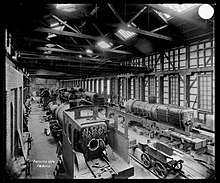
Addington | |
|---|---|
Suburb | |
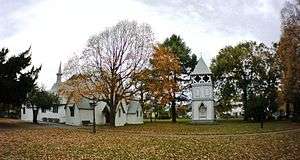 St Mary's Anglican Church, a central landmark of Addington | |
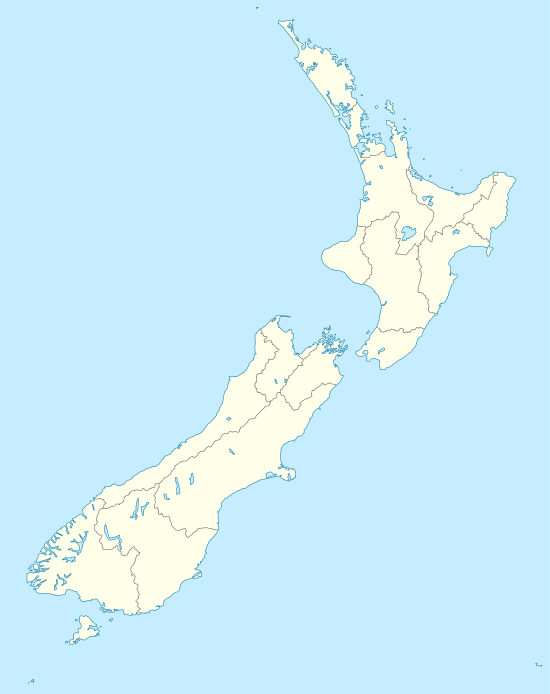 Addington 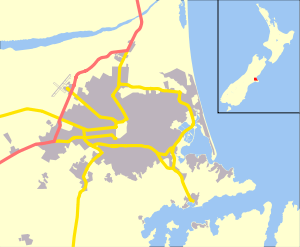 Addington | |
| Coordinates: 43°33′S 172°37′E | |
| Country | New Zealand |
| Local authority | Christchurch |
| Electoral ward | Spreydon |
| Established | 1860 |
| Area | |
| • Land | 106.4 ha (262.9 acres) |
| Population (2018)[1] | |
| • Total | 3,735 |
| Postcode(s) | 8041 |
| Upper Riccarton | Riccarton | Christchurch Central City |
| Middleton |
|
Sydenham |
| Hillmorton | Spreydon |
History
For the first decade after the founding of Christchurch in 1850, Addington was farmland, consisting of large rural sections. In the early 1860s, the railway was surveyed through the area and subdivision of the larger sections began. Factories moved in; wool and grain sheds opened; and with the industry came working class residential settlement.
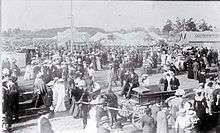
Development continued throughout the 19th century: the city's sale yards opened in 1874 and the railway workshops were moved to Addington in 1880. By the time the show grounds were opened in 1887, Addington had become an important suburb in the industrial and social life of Christchurch.[2]
Description
The suburb was named for the country residence of Archbishop John Sumner, one of the leading members of the Canterbury Association, and who was buried in St Mary's Church, Addington in England.[3]
As an inner city suburb, Addington has a mix of residential, retail and light industrial properties. The suburb is home to multiple sporting and events complexes, including Horncastle Arena, Rugby League Park (currently branded as Orangetheory Stadium), and Addington Raceway. Along with Riccarton Racecourse, the Raceway is one of Christchurch's primary horse-racing venues, focusing predominantly on harness racing, and is the home to the annual New Zealand Trotting Cup. Addington is also close to many other event venues, notably Hagley Park to the north and the Canterbury Agricultural Park to the southwest.
The New Zealand Railways Department's Addington Workshops were situated here until their closure in the 1980s; the historic concrete water-tower survives, next to the new Christchurch railway station. The tower has served as the centrepoint for the adjacent Tower Junction shopping complex. The previous railway station is located on Moorhouse Avenue in neighbouring Sydenham. The new station at Addington opened in 1994 and now serves the TranzAlpine, which takes tourists on the 223km (139mi) coast-to-coast journey from Christchurch to Greymouth and is considered one of the most spectacular train rides in the world, and the Coastal Pacific, which takes a 348-kilometre (216 mi) journey to Picton.
Addington was the home of the oldest blending plant in the Southern Hemisphere until it was demolished after sustaining some damage in the February 2011 Christchurch earthquake. The demolition of the plant sparked some controversy as the plant had been lined up to be carefully taken apart in an attempt to save Oregon timber valued at over $600,000.[4]
Central to Addington's residential area is St Mary's Anglican Church, which is a historic building surrounded by the spacious grounds and trees of Church Square. The grounds are used by the community for galas, pancake races (on Shrove Tuesday) fairs and weddings. The buildings and surrounding area is registered by Heritage New Zealand as a historic area, with registration number 7516.[5]
The Court Theatre, whose buildings were damaged in the earthquake, relocated to "The Shed" and started operating on 10 December 2011.
Manuka Cottage is a community house that serves the interests of a wide variety of people and local community groups.[6]
References
- The population is the sum of the population in statistical areas of Addington North, Addington East, and Addington West.
- Wilson, John (2018). LOCAL LIVES A History of Addington. p. 29.
- Reed, A. W. (2010). Peter Dowling (ed.). Place Names of New Zealand. Rosedale, North Shore: Raupo. p. 17. ISBN 978-0-14-320410-7.
- "Tensions rise as historic building demolished". Television New Zealand. 15 March 2011. Retrieved 15 September 2011.
- "Church of St Mary the Virgin Historic Area". NZHPT. Retrieved 2 September 2011.
- "MANUKA COTTAGE - ADDINGTON COMMUNITY HOUSE". Mental Health Education and Resource Centre. Retrieved 21 July 2018.